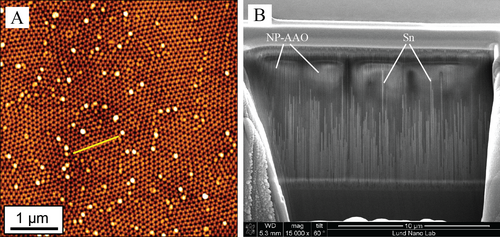Anodization

Aluminum is used in a vast number of everyday applications in modern society. During the last 5-10 years we have studied the electro chemical anodization (electro-oxidation) of aluminium and aluminium alloys [1], an industrial process to increase the corrosion resistance and color of aluminium, using Grazing Incidence X-ray Diffraction (GISXRD), X-Ray Reflectivity (XRR) and Grazing Incidence Small Angle Scattering (GISAXS). In particular we have followed the growth [2] and electrodeposition of metals [3] into Nanoporous Anodic Al Oxide (NP-AAO) for functionalization and templated nano wire growth, with potential applications in catalysis and III-V semiconductor nano wire growth.
References
[1] Anodization of Al (100), Al (111) and Al Alloy 6063 studied in situ with X-ray reflectivity and electrochemical impedance spectroscopy.
J. Evertsson, F. Bertram, L. Rullik, G. Harlow, E. Lundgren, Journal of Electroanalytical Chemistry 799 (2017) 556.
[2] Observation of pore growth and self-organization in anodic alumina by time-resolved x-ray scattering.
N. A. Vinogradov, G. S. Harlow , F. Carlà, J. Evertsson, L. Rullik, W. Linpé, R. Felici and E. Lundgren,
ACS Appl. Nano Mater. 1 (2018) 1265.
[3] Electrochemical Fabrication and Characterization of Palladium Nanowires in Nanoporous Alumina Templates
A. Larsson, G. Abbondanza, W. Linpe, F. Carla, P. Mousley, C. Hetherington, E. Lundgren, G. S. Harlow J. Electrochem. Soc. 167 (2020) 122514.
